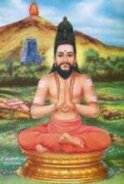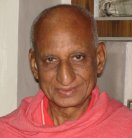

THE ESOTERIC
KANDAR ANUBHUTI
OR
THE SECRET TEACHING ON
GOD-EXPERIENCE
(A Treatise on Adwaitic Realization)
OF
SAINT ARUNAGIRINATHAR

 |  THE ESOTERIC KANDAR ANUBHUTI OR THE SECRET TEACHING ON GOD-EXPERIENCE (A Treatise on Adwaitic Realization) OF SAINT ARUNAGIRINATHAR |  |
 | by N.V. Karthikeyan |  |
| verses contents 37 38 39 40 41 42 43 44 45 46 .. 51 this verse in PDF version (8 parts) p-1 p-2 p-3 p-4 p-5 p-6 p-7 p-8 complete download of this book |
VERSE-42 குறியைக் குறியாது குறித்தறியும் நெறியைத் தனிவேலை நிகழ்த்திடலும் செறிவற்று உலகோடு உரை சிந்தையுமற்று அறிவற்று அறியாமையும் அற்றதுவே.Kuriyaik kuriyaathu kuritthariyum, Neriyait thanivelai nikazhtthidalum Cherivatru ulakodu urai sinthaiyum atru, Arivatru ariyaamaiyum atrathuve. To know the Object Supreme by thinking without thinking, Commentary This is the only verse in the whole work where there is no reference to the Lord; perhaps because it is the state of Samadhi or the supervening of Super-consciousness. Yes, by the Grace of God/Guru, the Goal has been reached, the Vel revealed Itself, Brahman-Consciousness supervened, Jivanmukti attained, and Ignorance with all its retinue ceased to be! The great struggle has yielded the Fruit of Brahmajnana! This is a verse of the mystic experience of Samadhi, very difficult to understand even for oneself, more difficult to explain in words, but is indeed the most blessed state to Experience. Experience is experience; it cannot be understood, much less explained, but only to be 'experienced'. It is the culmination and consummation of lifelong Sadhana coupled with divine grace. The disciple put into practice the Guru's instructions of verse-37, in Toto, and attained Samadhi, the Goal, God-Realization. The Guru instructed him: (1) to meditate on 'Aham Brahma Asmi' (Iraiyon parivaaram) and aspire to realise/attain that state (enum padam mevalaiye purivai); (2) and by 'Poraiyaam Arivaal' -- Knowledge called Serenity or Consciousness-Being (Chit-svaroopa); (3) 'Arivaai adiyodum agandaiyaiye' -- destroy the ego-sense by its root. Accordingly, the disciple commenced the practice in all earnestness in verse-40 by uninterrupted meditation on the Karma-destroying Vel and continued it with a prayer (longing) for Immediate Realization here and now (Jivanmukti) in verse-41, and realised the Goal in this verse. How? குறி 'Kuri' - means Lakshya or the Object to be attained, i.e., Brahman. குறித்து 'Kuriththu' means 'to think of' or concentration on the Object; in this thinking or concentration on Brahman, there are also extraneous thoughts disturbing or distracting the concentration. குறியாது குறித்து 'Kuriyaathu' means without thinking of anything else, i.e., without any distractions; 'Kuriyaathu kuriththu' means total concentration on the Object without any distraction. There is an unbroken thought of the Object only, like the continuous flow of oil from one vessel to another. This is meditation. It is a process wherein there are three things: the meditator, the Object of meditation and the act of meditation or thinking. When this undistracted meditation is deepened by practice over a protracted period, there ensues Samadhi. அறிதல் 'Arithal' means to Know or Experience, i.e., Samadhi. In Samadhi the meditator and act of meditation merge into the Object (Brahman), which alone IS. குறியைக் குறியாது குறித்து அறிதல் 'Kuriyaik kuriyaathu kuriththu arithal' means to meditate on Brahman without any other thought, by which the mind enters into Brahman and becomes Brahman (like the river entering into the ocean and becomes the ocean itself), and Knows Brahman by Being Brahman. This is Samadhi. This is the 'State' of Liberation or Mukti or Moksha. This phrase -- குறியைக் குறியாது குறித்து அறிதல் -- explains the process of true meditation resulting in Samadhi. நெறி 'Neri': Its meaning is முத்தி, i.e., Moksha or Liberation. It is not a 'means' or way (to some thing), but a 'State' of Consciousness (Samadhi). குறியைக் குறியாது குறித்து அறிதல் 'Kuriyaik kuriyaathu kuriththu arithal' and நெறி 'Neri' -- They both mean the same thing -- Samadhi or Moksha. Thus, by meditation on Brahman, the Absolute, without thinking (குறியாது -- kuriyaadhu) of anything else, with a totally concentrated mind (ekaagra chitta) fixed on Brahman [குறியை (மட்டும்) குறித்து -- Kuriyai (mattum) kuriththu], he Experienced or Realised Brahman (அறிதல்), which is the state of Samadhi or Moksha or Liberation (நெறி -- Neri). 'நெறி' is 'முத்தி' or Moksha; it is not 'a means' to Moksha. This 'Neri' was referred to as 'Padam' (பதம்) in verse-37, which the seeker was asked to attain. In Samadhi the meditating Jiva-consciousness merges into Brahman-Consciousness and becomes Brahman, and then BE Brahman, like the river rushing towards the ocean and merging with the ocean at the confluence and then become and BE the ocean itself. In Samadhi, one Experiences or Knows Brahman by being Brahman, i.e., Knowing and Being is the same; Sat is Chit. And, Brahman is Pure Consciousness (Prajnanam Brahma); even so is the Vel. Brahman, Vel, Moksha, Consciousness, Samadhi, Liberation, Lord's Feet -- all these mean one and the same. So Arunagiri says 'Neriyai' (நெறியை) -- Moksha, 'Thani Velai' (தனிவேலை) - Supreme Consciousness, thereby equating them with one another, showing they both mean the same thing, and not two different things. If they were two different things that were granted, he would have said 'Neriyaiyum Thani Velaiyum'. So, Arunagiri says 'Neriyai', 'Thani Velai' 'Nigazhthidalum' (நெறியைத் தனிவேலை நிகழ்த்திடலும்). 'Nigazhthuthal' means 'make it happen' or 'supervene'. Moksha, Samadhi, Vel, Super-consciousness, etc., are 'States' of Pure Consciousness; these are 'not given' but they 'happen' or 'supervene', by the Grace of Guru/God. Samadhi or Super-conscious State spontaneously supervenes at the end of meditation. While meditation is a process, Samadhi is a state or condition of 'Being' which spontaneously 'supervenes'. Hence, it is mentioned as 'Nigazhthidalum' (நிகழ்த்திடலும்), i.e., made to happen or supervene (by the Grace of the Lord). When Samadhi/Vel-Consciousness supervened, "All relationship with the people and the world ceased, speech and mind also ceased, intellect (ego) ceased and ignorance, too, ceased." The instruction of verse-37 was to destroy 'ego with its root' (arivaai adiyoodum aganthaiyaiyee), and when the root is destroyed, naturally the branches, twigs, leaves, etc. get destroyed. So here it is said that not only the ego's root, Avidya or Ignorance (Ariyaamai) is destroyed, but also the intellect, mind, speech and all relationships came to an end. Thus we see a complete correspondence between the instructions of verse-37 and its Realization in this verse. It is in this verse that there is a categorical declaration that Avidya or Ariyaamai has been completely destroyed; the Ariyaamai which remained unpardoned (not destroyed) after the near Cosmic Consciousness experience (verses 28 and 29) and to destroy which was the instruction in verse-37. How this state of Samadhi supervenes is indeed a wonder. By a mysterious combination of Purva Punya (accumulated past merits), one's Sadhana-Sakti (power of one's spiritual practice), Guru's power of initiation (Shakti-paata) and Isvara Kripa (God's grace) the Vel or Super-consciousness reveals itself. This is the state of Turiya, i.e., consciousness in Its transcendental state, bereft of its relation with the five Kosas (sheaths), which is so precisely conveyed in the verse. Relationship with the world is established by the body (the organs of action) which is the Annamaya Kosa (physical sheath). Speech, which is due to the operation of the Prana, represents Pranamaya Kosa (vital sheath). Mind is Manomaya Kosa (mental sheath). Intellect is Vijnanamaya Kosa (intellectual sheath). Ignorance or Avidya is the Aanandamaya Kosa (bliss sheath). Thus, all the five Kosas cease functioning when the Jiva enters into Samadhi. This is also the state of Supreme Mowna (Silence), the 'Pesaa Anubhuti' of the next verse, and the granting of the Lord's Feet which shine in Moksha, etc., of verse-44. All the three verses (verse 42, 43, and 44) describe the attainment of the Goal, -- God-Realization, in three different ways. In this verse it is expressed in mystic terms (Jnana or Vel), and in the next it is explicitly said employing the term Anubhuti. Hence, that verse is regarded as the climax of the treatise. In verse-44 it is described in devotional terms (Bhakti or the Feet). But why should Arunagiri describe God-Realization in three verses? This we shall see in verse-44. What is said in this verse, exactly the same thing is said in verse-48 also in a more clarified form. As a result of the determined effort at establishment in the Vel-consciousness ("Aham Brahma Asmi") meditation (verse 40), which was duly intensified by a longing to attain the state of Jivanmukti (liberation) here and now (verse 41), the Sadhaka is now granted the state of Mukti (Vel-consciousness), by which the individuality-consciousness (Avidya) is annihilated. Here is an open and emphatic declaration that Avidya ceases (Ariyaamai Attradhu). This is the state of Samadhi - the state of Being-Consciousness (or "Knowledge called Serenity" - Poraiyaam Aviru) attained by meditation on "Aham Brahma Asmi", which destroys Avidya. This grand experience is portrayed more vividly and in positive terms in the next verse as "Pesaa Anubhuti" (speechless-experience). As seen in the last verse, the Vel and the Lord's Feet mean one and the same thing, and they go together. This is confirmed by this verse. How? That "non-thinking and the non-forgetting state (of Mukti), which is attainable by the grant of the Lord's Feet (verse 21)", is "the state (of Mukti) of knowing the Object by thinking-without-thinking" that is granted now (verse 42). The "Karudhaa Maravaa Neri" is the "Kuriyaik Kuriyaadhu Kuritthu Ariyum Neri", i.e., the "Neri" (Mukti) attainable by the grant of the Feet is had when the Vel is revealed. From this it is quite evident that the Feet and the Vel mean one and the same, i.e., Mukti or Liberation. Their non-difference can also be seen from verses 40 and 41 - while the effort in verse 40 was to fix oneself in an uninterrupted meditation on the Vel, the intensification of that effort is expressed as a longing for an immediate attainment of (protection under) the Feet in verse 41. The revelation of the Vel, in this verse, naturally implies the simultaneous granting of the Lord's Feet as well, which fact is, of course, explicitly and categorically declared in verse 44, which is an exclamation over, a gratitude for, as also an effect of, what has been granted now. In verse 21 also, "Neri" refers to Mukti and not a way (or method) because by the granting of the Lord's Feet, one attains Mukti and not merely a way to achieve something. The Lord's Feet (which represent Parama-pada or Omnipresence) are themselves the Object of attainment and not a means to something else. This is evident from the prayer in verse 35 wherein he says, "When shalt Thou grant me Thine Lotus Feet that I may attain Liberation (Mukti)," as also of the prayer of verse 41. So, the granting of the Feet is itself Mukti which again is confirmed in verse 44. Thus, "Neri" is "Mukti", i.e., a state and not a method; an end and not a means. There are two kinds of knowledge: knowledge-by-process and knowledge-by-being; sensory knowledge and pure self-consciousness (intuition); mediate knowledge and immediate or non-mediate knowledge. Knowledge obtained through perception, sensation, etc., i.e., obtained through the operation of the senses, mind, and intellect, is sensory knowledge. This knowledge comes by a process of knowing, in which the intellect, mind, and senses act as instruments or media to the knowing principle which is the Self or Consciousness. When the Consciousness, which is universal, gets associated, as it were, with these instruments, it gets involved in them and is limited to them. Then it begins to see things other than itself and knows them in a process. When the consciousness, thus, limited, objectifies itself through the individual mind, thinking takes place. When it further moves out and activates the senses and the organs (body), which are the means of contact, it establishes a relation with the world, through speech and action. Thus, the consciousness moves out and has knowledge of the world outside through the mind and senses, and establishes a contact with it through the body. This is the kind of knowledge that is known to us. The highest type of knowledge in this kind is intellectual knowledge, which is finally based on the report of the senses of the outside world. This is objectified knowledge; knowing by thinking; mediate knowledge. But, there is another kind of knowledge, a novel kind altogether. It is known as Self-consciousness or Intuition, which supervenes in the state of Samadhi or Realization. This is non-objectified awareness. This is the Vel-consciousness or "knowing the object by 'thinking-without-thinking'". These expressions carry mystic meanings, far beyond our intellectual grasp. Thinking without thinking, sleepless sleep, Vel-consciousness, etc., are very mystic. They all connote the state of Samadhi or Mukti, for which Arunagirinathar uses the term "Neri". Though it is impossible to explain what this state of Self-consciousness is, because it is an experience (i.e., to be had for oneself) - it can be made clear by proceeding on the lines of a simple analogy of our day-to-day experience. As we know, there is a difference between our knowing the existence of an object and knowing our own existence (as a bodily entity). How do we know that an object exists? By the process of perception and thinking, because the object known and the knowing subject (we) are not the same, i.e., they are two different entities standing apart. In other words, the existence of the object is separated from our consciousness of it. But, how do we know that we exist? Not by perception, not by thinking; we need not see ourselves to know that we exist, nor do we need to think or ratiocinate. We know ourselves by a kind of intuition or self-consciousness! What is this? The consciousness or the knowing principle in us gets so much identified with the body that it regards itself as the body and feels "I am", in the sense "I am the body". Here, for all practical purposes "I" means the body. In the perception of objects, the consciousness objectifies itself further, i.e., goes outside the body, and knows them. In our knowing of ourselves, the consciousness which has, thus, gone outside the body does nothing but to return to itself (i.e., the body) and be itself, and know itself as such, as "I am", without involving perception or thinking. The consciousness coming back to itself, being itself, and knowing itself -- this is intuition or self-consciousness -- this is knowing by "thinking without thinking". This is knowing by being, wherein both knowing and being are one, i.e., being itself is knowing. This, of course, is the crudest form of intuition or self-consciousness because, here, there are still two things -- the inert body and the knowing consciousness -- which are superimposed on each other. The Jiva-consciousness to regard itself as the body is the lowest degree of self-consciousness and there are higher degrees of self-consciousness -- the consciousness identified with the mind, with the intellect, and with the ego or Avidya -- when it feels, respectively, "I am happy, I am dejected"; "I know, I am baffled"; and "I exist or I am" with the feeling that it (the Jiva-consciousness) has an independent existence of its own isolated form the cosmic existence of Isvara. This Jivatva or pure Jiva-consciousness is the highest degree of self-consciousness of the Jiva, wherein the universal consciousness gets reflected in Avidya or individuality, and forgetting its universal nature asserts its limited existence as "I am." Thus, the feeling "I am body, I am mind, etc.," are the different degrees of self-consciousness of the Jiva-consciousness. But, in Self-consciousness (Intuition) proper, there is a return of this identified or Jiva-consciousness to its Source - the universal condition of Isvaratva - and Consciousness, bereft of any associations, knows Itself by being Itself. It is difficult to say what knows what, which is the knower and which is the known, because the universal is both the subject and the object, the knower and the known. It is the Universal knowing itself. Something is, and That knows itself as "I am" -- Ahamasmi. It is Self-consciousness of Universal Being -- It is Being-Consciousness. The return of the objectified Jiva-consciousness to itself is, in a limited sense, self-consciousness. And the return of the pure Jiva-consciousness to Isvara or God is real Self-consciousness -- in both the cases, there is no extroverted knowing, but Knowing by Being. Here the pertinent question, "Can one thing really become another?" may be raised. Indeed one thing cannot really be (or become) another; but a thing which has imagined itself to be something other than what it really is, can be freed from its false imagination (for which purpose is meditation prescribed and practised) and be what it really is (which is realisation). Now, how does the Jiva become (or be) Isvara (God) and know Him? There is an element of God in man. When man sheds his human elements (or faculties), the God-element, left to itself, realises Itself as such. So, it is God realising God, not man realising God. How can one thing realise another thing? How can man realise God? Hence, it is significantly said as God-realisation, Self-realisation, or Sakshatkara (one thing realising Itself), and not as man-realisation. It is God-experience, not man-experience. The Vedantic method of Neti, Neti (not this, not this) doctrine and Abheda Brahma Chintan with Aham Brahmasmi Bhavana: Consciousness, which is universal in its nature, gets limited to individuality (Avidya) and objectifies itself through the intellect and mind, and finally establishes a relationship with the world through the senses and the body. The consciousness, in a state of delusion, regards itself as the body, senses, etc. When the Guru gives Mahavakya Upadesa and instructs the disciple to meditate on "Aham Brahma Asmi," the consciousness gets awakened to its real nature. Now, the process of meditation starts. The consciousness, which in identification with the body, thought "I am the body, I am Mr. so and so, I am tall, etc." knowing itself to be different from the body, because the body is inert, feels "(I am) not this (body)." Together with this, it affirms its real nature, as initiated by the Guru, as Aham Brahma Asmi (I am Brahman). In the same way, the consciousness withdraws itself from the senses, mind, intellect, ego, and Avidya, saying, "(I am) not this; (I am) not this." Thus, when the Consciousness sheds all its limiting adjuncts and finally rests in itself, stands by itself (bereft of all associations) it is itself and knows itself and experiences "I am consciousness" - "I am Brahman." In the meditation 'Aham Brahma Asmi' or 'I am Brahman', it is not that "I" is one thing and "Brahman" is another thing; it is not one thing says (or feels), "I am another". It is not the Jiva's egoistic assertion, "I am Brahman." As we have seen, Brahman Itself goes by the name of Jiva when limited to the Upadhis. It is not this limited Jiva-consciousness, in the state of Avidya, that feels, "I am Brahman", but Brahman Himself that feels so. It is one thing feeling and experiencing that it is itself only. It is what is that knows what it is. It is Self-consciousness of God as "I am" (or "Ahamasmi"). It is something like this: when we ask Mr. Krishna, "Who are you?" he would say, "I am Krishna." But to himself, he does not say, "I am Krishna", but only feels, "I am" or "I exist". Similarly, when the Guru gives initiation saying, "Tat Tvam Asi" (Thou art That), the student says, "Aham Brahma Asmi" (I am Brahman) and also affirms so in meditation while negating the body, etc., by the Neti-Neti, doctrine. Finally, as a result of intense and prolonged meditation and the dawn of Divine Grace, Self-consciousness supervenes in Samadhi and the Jiva-consciousness attains freedom (liberation) - Mukti. The liberated consciousness rests in itself and knows itself as "Ahamasmi". Mukti (God-realization) is not necessarily an after-death attainment but an experience (or state of consciousness) which can be had here and now, while yet living in this body. This is called Jivanmukti and it has been attained by many saints like Appar, Sundarar, Jnana-Sambanthar, Arunagirinathar, Swami Sivananda, and others. Mukti can be attained here itself because God is not somewhere in the seventh heaven (or in some particular place) so that the soul has to go there, after death, to attain Him. He is the universal Reality, Omnipresent, and Omniscient. He is everywhere and so He must be attainable here itself. If God cannot be experienced 'here', He cannot be experienced 'there', also. And if God is elsewhere, He must also be here; otherwise, He ceases to be the God eternal and becomes an object, like any other object, however big, superior, and glorified He might be, and will be subject to the limitations of an object. Hence, Mukti is and can be attained here itself and this is the state conferred in this verse, which is denoted by the terms "Neri" and "Incomparable Vel". It is interesting to note that, in the work Kandar Anubhuti, Arunagirinathar employs the term "Neri" only in two verses - Verses 21 and 42; the former verse is a prayer to grant His Lotus Feet to attain Mukti and the latter is granting of Mukti. The master-stroke comes when Arunagirinathar completes the verse saying, "No sooner is this granted than the relations with the world ceased, speech ceased, mind ceased, intellect ceased, and ignorance (Avidya) also ceased." All this is achieved, especially the destruction of Avidya, only when the Jiva is absorbed in God, i.e., in Self-consciousness. The Universal, due to Avidya, regards itself as the particular and in the process of meditation, when the Jiva is granted the Vel (or the state of Knowing the Object - the Universal -- by thinking-without-thinking), it returns to Itself, and Avidya is destroyed. Avidya cannot cease to exist by mere instruction on a technique of meditation. |
| contents 37 38 39 40 41 42 43 44 45 46 .. 51 this verse in PDF version (8 parts) p-1 p-2 p-3 p-4 p-5 p-6 p-7 p-8 |
| ... www.kaumaram.com ... The website for Lord Murugan and His Devotees முகப்பு கௌமாரம் அட்டவணை மேலே தேடல் home Kaumaram contents top search |
Kaumaram.com is a non-commercial website. This website is a dedication of Love for Lord Murugan. Please take note that Kaumaram.com DOES NOT solicit any funding, DIRECTLY or INDIRECTLY. |